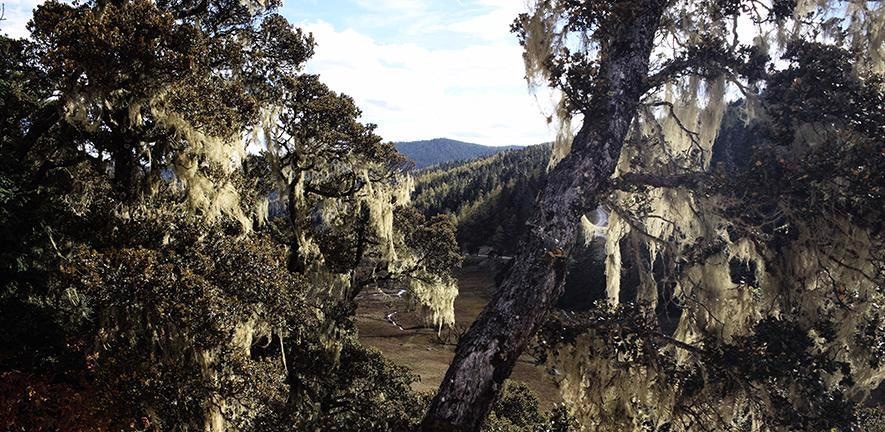Feb 8 2021
The first-ever evidence of a mechanism through which climate change could have had a direct role in the origin of SARS-CoV-2—the virus responsible for the COVID-19 pandemic—has been offered by a new study.
 Forest landscape in Yunnan province of China. Image Credit: Credit: Shi bai Xiao/Greenpeace.
Forest landscape in Yunnan province of China. Image Credit: Credit: Shi bai Xiao/Greenpeace.
Published recently in the Science of the Total Environment journal, the study unraveled large-scale variations in the vegetation type in the southern Chinese Yunnan province, and nearby regions in Laos and Myanmar, in the past century.
Changes to the climate, such as increases in sunlight, temperature and atmospheric carbon dioxide—which have an impact on the growth of plants and trees—have transformed natural habitats from tropical shrubland to tropical savannah and deciduous woodland.
This has led to an environment suitable for several bat species that mainly live in forests.
The number of coronaviruses in a region is closely associated with the number of various bat species present.
The research identified that 40 more bat species have shifted to the southern Chinese Yunnan province in the last century, hosting nearly 100 more forms of bat-borne coronavirus. This 'global hotspot' is the region in which genetic data indicates SARS-CoV-2 may have emerged.
Climate change over the last century has made the habitat in the southern Chinese Yunnan province suitable for more bat species. Understanding how the global distribution of bat species has shifted as a result of climate change may be an important step in reconstructing the origin of the COVID-19 outbreak.
Dr Robert Beyer, Study First Author and Researcher, Department of Zoology, University of Cambridge
Dr Beyer has recently taken up a European research fellowship at the Potsdam Institute for Climate Impact Research in Germany.
The researchers obtained their results by developing a map of the world’s vegetation as it was 100 years ago. For this, they used records of precipitation, temperature and cloud cover. The team then used information on the vegetation requirements of the bat species across the world to calculate the global distribution of each species in the early 1900s.
By comparing this with the current distributions, they could observe how bat 'species richness,' or the number of various species, has varied across the planet in the past century because of climate change.
As climate change altered habitats, species left some areas and moved into others—taking their viruses with them. This not only altered the regions where viruses are present, but most likely allowed for new interactions between animals and viruses, causing more harmful viruses to be transmitted or evolve.
Dr Robert Beyer, Study First Author and Researcher, Department of Zoology, University of Cambridge
The bat population across the world harbors nearly 3,000 distinct types of coronavirus, where each species hosts 2.7 coronaviruses on average—a majority of them without any symptoms. A climate change-induced increase in the number of bat species in a specific region may increase the chances of the presence, transmission, or evolution of a coronavirus harmful to humans.
A majority of the coronaviruses harbored by bats cannot find their way into humans. However, there higher chances for numerous coronaviruses known to infect humans to have evolved in bats, which include three types that can cause death in humans: Middle East Respiratory Syndrome (MERS) CoV and Severe Acute Respiratory Syndrome (SARS) CoV-1 and CoV-2.
The region found by the research as a hotspot for a climate-induced increase in bat species richness is also the habitat of pangolins, which are indicated to have served as intermediate hosts to SARS-CoV-2. The virus might have been transmitted from bats to these animals, which were then traded at a wildlife market in Wuhan—where the first human outbreak emerged.
The team supports calls from earlier studies that push policy-makers to accept the role of climate change in viral disease outbreaks, and to mitigate climate change as part of COVID-19 economic recovery programs.
The COVID-19 pandemic has caused tremendous social and economic damage. Governments must seize the opportunity to reduce health risks from infectious diseases by taking decisive action to mitigate climate change.
Andrea Manica, Professor, Department of Zoology, University of Cambridge.
“The fact that climate change can accelerate the transmission of wildlife pathogens to humans should be an urgent wake-up call to reduce global emissions,” noted Professor Camilo Mora from the University of Hawai‘i at Manoa, who initiated the project.
The researchers stressed the need to restrict the expansion of farmland, urban areas and hunting grounds into natural habitats to minimize contact between humans and disease-carrying animals.
The research demonstrated that in the past century, climate change has also induced increases in the number of bat species in areas close to Central Africa, and a few isolated patches in Central and South America.
This study was supported by the European Research Council.
Journal Reference:
Beyer, R. M., et al. (2020) Shifts in global bat diversity suggest a possible role of climate change in the emergence of SARS-CoV-1 and SARS-CoV-2. Science of the Total Environment. doi.org/10.1016/j.scitotenv.2021.145413.